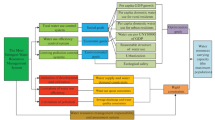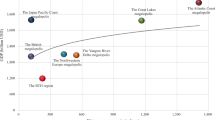Abstract
As water has become the shortest resources in arid, semi-arid and rapid urbanization areas when the water resources utilization has approached or exceeded its threshold, water resources system slows down the socio-economic growth rate and destroys the projected targets to eradicate poverty and realize sustainable development. We put forward the concept of Water Resources Constraint Force (WRCF) and constructed a conceptual framework on it. Conceptual models on the interactions and feedbacks between water resources and socio-economic systems in water scarce regions or river basins indicate that, if the socio-economic system always aims at sustainable development, WRCF will vary with a normal distribution curve. Rational water resources management plays an important role on this optimistic variation law. Specifically, Water Demand Management (WDM) and Integrated Water Resources Management (IWRM) are considered as an important perspective and approach to alleviate WRCF. A case study in the Hexi Corridor of NW China indicates that, water resources management has great impact on WRCF both in Zhangye and Wuwei Region, and also the river basins where they are located. The drastic transformation of water resources management pattern and the experimental project – Building Water-saving Society in Zhangye Region alleviated the WRCF to some extent. However, from a water resources management view, WRCF in Zhangye Region still belongs to the severe constraint type. It will soon step into the very severe constraint type. In order to shorten the periods from the very severe constraint type finally to the slight constraint type, WDM and IWRM in the Hei River Basin should be improved as soon as possible. However, in the Shiyang River Basin, WRCF belongs to the very severe constraint type at present due to poor water resources management in the past. Though the socio-economic system adapted itself and alleviated the WRCF to some extent, the Shiyang River Basin had to transform the water supply management pattern to WDM, and seek IWRM in recent years. It is concluded that WDM and IWRM is a natural selection to alleviate the WRCF on the socio-economic system and realize sustainable development.
Similar content being viewed by others
References
Al Radif A (1999) Integrated water resources management (IWRM): an approach to face the challenges of the next century and to avert future crises. Desalination 124(1–3):145–153
Alcamo J, Doll P, Kaspar F, Siebert S (1997) Global change and global scenarios of water use and availability: an application of WaterGAP 1.0. University of Kassel, CESR, Kassel, Germany
Appelgren B, Klohn W (1999) Management of water scarcity: a focus on social capacities and options. Phys Chem Earth, B 24(4):361–373
Arnell NW (2004) Climate change and global water resources: SRES emissions and socio-economic scenarios. Global Environmental Change: Human and Policy Dimensions 14(1):31–52
Biswas AK (1991) Water for sustainable development in the 21st century: a global perspective. Int J Water Resour Dev 7(4):219–224
Chen Y et al. (2005) Water demand management: a case study of the Heihe River Basin in China. Phys Chem Earth 30(6–7):408–419
Clark C (1940) The conditions of economic progress. Garland, Garland
Clarke R, King J (2004) The water atlas. New Press, New York
Cohen JE (2003) Human population: the next half century. Science 302:1172–1175
Falkenmark M (1986) Macro-scale water supply/demand comparisons on the GlobalScene – a hydrological approach. Beitragzur Hydrologie 6:15–40
Falkenmark M (1998a) Dilemma when entering 21st century – rapid change but lack of sense of urgency. Water Policy 1(4):421–436
Falkenmark M (1998b) Preparing for the future: water for a growing population. J Water Services Res Technol-Aqua 47(4):161–166
Falkenmark M, Carl W (1992) Population and water resources: a delicate balance. In: Population Bulletin. Population Reference Bureau, Washington, DC
Frederick KD (1993) Balancing water demands with supplies: the role of management in a world of increasing scarcity. World Bank Technical Paper no. 189, The World Bank, Washington, DC
Gao Y, Liu C (1997) Limit analysis on the development and utilization of regional water resources. J Hydraul Eng 8:73–79 (in Chinese)
Good DH, Reuveny R (2006) The fate of Easter Island: the limits of resource management institutions. Ecol Econ 58(3):473–490
Guan D, Hubacek K (2006) Assessment of regional trade and virtual water flows in China. Ecol Econ (in press)
Jewitt G (2002) Can integrated water resources management sustain the provision of ecosystem goods and services? Phys Chem Earth 27(11–12):887–895
Jury WA, Vaux H Jr (2005) The role of science in solving the world’s emerging water problems. Proc Natl Acad Sci U S A 102(44):15715–15720
Khan S et al (2006) Can irrigation be sustainable? Agric Water Manag 80(1–3):87–99
Kindleberger CP (1996) World economic perspectives: 1500 to 1990. Oxford University Press, Oxford, UK
Knapp J (1995) Water use in arid and semi-arid regions: in the hands of local and watershed-level managers. J Soil Water Conserv 50:412–423
Li L, Gan H (2000) Remark on the relationship between water resources rational allocation, carrying capacity and sustainable development. Advance in Water Science 11(3):307–313 (in Chinese)
Li S, Cheng G et al (2002) Rational utilization of water resources and eco-environmental protection in the Hexi Corridor. The Yellow River Water Conservancy, Zhengzhou, p 67 (in Chinese)
Long T, Jiang W, He Q (2004) Water resources carrying capacity: new perspectives based on eco-economic analysis and sustainable development. J Hydraul Eng 1:38–45 (in Chinese)
Lundqvist J et al (2005) Water management in megacities. Ambio 34(3):267–268
Ma JZ, Wang XS, Edmunds WM (2005) The characteristics of ground-water resources and their changes under the impacts of human activity in the arid Northwest China – a case study of the Shiyang River Basin. J Arid Environ 61(2):277–295
Matondo JI (2002) A comparison between conventional and integrated water resources planning and management. Phys Chem Earth 27(11–12):831–838
Matthias R (2006) A quest for the economics of sustainability and the sustainability of economics. Ecol Econ 56(3):332–342
McGranahan G, Satterthwaite D (2003) Urban centers: an assessment of sustainability. Annu Rev Environ Resour 28:243–274
Meyer PS, Yung JW, Ausubel JH (1999) A primer on logistic growth and substitution: the mathematics of the loglet lab software. Technol Forecast Soc Change 61(3):247–271
Mudege NR, Taylor P (2001) Implementing integrated water resources management in Southern Africa: a focus on capacity building efforts and strategies. Background Paper to the Proposal on the Elaboration of PCN: WaterNet
Northam RM (1975) Urban geography. Wiley, New York
Ohlsson L (2000) Water conflicts and social resource scarcity. Phys Chem Earth, B 25(3):213–220
Okadera T, Watanabe M, Xu K (2006) Analysis of water demand and water pollutant discharge using a regional input–output table: an application to the City of Chongqing, upstream of the Three Gorges Dam in China. Ecol Econ 58(2):22–237
Olli V, Pertti V (2001) China’s 8 challenges to water resources management in the first quarter of the 21st century. Geomorphology 41(2–3):93–104
Postel SL, Daily GC, Ehrlich PR (1996) Human appropriation of renewable fresh water. Science 271(5250):785–788
Qiu B (2004) Main lessons concerning urbanization from foreign countries. City Planning Review 28(4):8–12 (in Chinese)
Raskin P, Gleick P, Kirshen P, Pontius G, Strzepek K (1997) Water futures: assessment of long-range patterns and prospects. Stockholm Environment Institute, Stockholm, Sweden
Reid L, Ziemer R (1997) Basin assessment and watershed analysis. In: Reid L (ed) Issues in watershed analysis. USDA forest service pacific southwest research station. Redwood Sciences Laboratory, Arcat, CA
Rijsberman FR (2006) Water scarcity: fact or fiction? Agric Water Manag 80(1–3):5–22
Seckler D et al (1998) World water demand and supply, 1990 to 2025: scenarios and issues. IWMI Research Report 19. IWMI, Colombo, Sri Lanka
Seidl I, Tisdell CA (1999) Carrying capacity reconsidered: from Malthus’ population theory to cultural carrying capacity. Ecol Econ 31(3):395–408
Shiklomanov IA (1991) The world’s water resources. In: Proceedings of the international symposium to commemorate 25 years of the IHP, UNESCO/IHP, Paris, France, pp 93–126
Simonovic SP (2000) A shared vision for management of water resources. Water Int 25(1):76–88
UNDP (1990) Human development report. Oxford University Press, Oxford
United Nations Centre for Human Settlements (2001) Cities in a globalizing world: global report on human settlements 2001. Earthscan, London, UK
Van der Zaag P (2005) Integrated water resources management: relevant concept or irrelevant buzzword? A capacity building and research agenda for Southern Africa. Phys Chem Earth 30(11–16):867–871
Vorosmarty CJ, Sahagian D (2000) Anthropogenic disturbance of the terrestrial water cycle. Bioscience 50(9):753–765
Vorosmarty CJ, Green P, Salisbury J, Lammers RB (2000) Global water resources: vulnerability from climate change and population growth. Science 289(5477):284–288
Wang L (2002) Discussion on the problems of the water resources shortage in Hexi Corridor Oasis. J Arid Land Resour Environ 16(4):48–52 (in Chinese)
Wang C (2005) Supply management of enterprises – a view of “Wooden Barrel Principle”. Enterprises and Market 5:46–47 (in Chinese)
Wang G, Cheng G (1999) Water resource development and its influence on the environment in arid areas of China – the case of the Hei River basin. J Arid Environ 43(2):121–131
Wilson EO, Bossert WH (1971) A primer on population biology. Sinauer Associates, Stamford, CT
Xu Z, Long A (2004) The primary study on assessing social water scarcity in China. Acta Geogr Sin 59(6):982–988 (in Chinese)
Zarghaami M (2006) Integrated water resources management in Polrud irrigation system. Water Resour Manag 20(2):215–225
Zhang J (2006) Barriers to water markets in the Heihe River basin in northwest China. Agric Water Manag (in press)
Zhang Q et al (2002) Modeling water security in China and comparison of the strategies. Advance in Water Science 13(5):569–577 (in Chinese)
Author information
Authors and Affiliations
Corresponding author
Rights and permissions
About this article
Cite this article
Fang, Cl., Bao, C. & Huang, Jc. Management Implications to Water Resources Constraint Force on Socio-economic System in Rapid Urbanization: A Case Study of the Hexi Corridor, NW China. Water Resour Manage 21, 1613–1633 (2007). https://doi.org/10.1007/s11269-006-9117-0
Received:
Accepted:
Published:
Issue Date:
DOI: https://doi.org/10.1007/s11269-006-9117-0




